The finalists for the Vezina Trophy were announced on Monday. In no particular order, Vancouver's Thatcher Demko, Winnipeg's Connor Hellebuyck, and Florida's Sergei Bobrovsky were all voted as the top-3 goalies this season. The winner will be announced at the NHL Awards at the end of June.
This is Demko's first time finishing in the top-3 for the goalie of the year and he's been tremendous basically since returning from injury in February of 2023.
Connor Hellebuyck is a Vezina finalist for the fourth time in his career and his second time in three years, having won it in 2019-20.
Sergei Bobrovsky won the trophy twice with Columbus – 2012-13 and 2016-17 – though those were the only times he finished inside the top-6 for Vezina voting, let alone top-3. It was a nice rebound year from him after a subpar regular season (but great postseason) last year.
We should all keep in mind that it is the general managers, and not the media or players, that vote on the three goalies selected. There has not been a non-playoff goalie nominated, let alone a non-playoff winner, since 2013.
*
Dave Hakstol was fired by Seattle on Monday. A season after making the postseason, the Kraken failed to qualify for the playoffs and missed the cutoff by 17 points. The team said there will be a coaching search ongoing, but this very much seems to be a franchise that is too talented to truly bottom out and not talented enough to be a serious Cup threat. The Vegas Golden Knights, they are not.
*
Toronto signed 2022 fifth-round pick Nikita Grebyonkin to an entry-level contract. He makes his way from the KHL on the back of a 19-goal, 41-point season across 67 games.
*
It took an extra game but the Tampa Bay Lightning were the second team eliminated from the postseason thanks to a 6-1 loss in Florida. The Lightning had two goals disallowed due to goaltender interference, though one of them seemed a very marginal call. Either way, Florida moves on and will face the winner from the Boston/Toronto series.
Aleksander Barkov came up big with his first goals of the playoffs, tallying a short-handed game-winner and adding the insurance marker in the third period. Barkov finished the game with two goals, one assist, four shots, two blocks, and four hits. That is a stat-stuffing performance.
Carter Verhaeghe also had two goals and an assist, totalling eight shots in all. He had five goals and four assists with 22 shots in five games against Tampa Bay. This guy, he's pretty good.
Victor Hedman scored Tampa Bay's lone goal, managing six shots, three blocks, and four hits. Nikita Kucherov assisted on that goal, and that gave him seven assists in the series, meaning he had a point on half of the Lightning's goals.
*
Vegas and Dallas may be giving us the best series of the first round. After going down 2-0 in the series due to two home losses, Dallas has clawed all the way back to a 2-2 series tie thanks to a 4-2 win in Vegas on Monday night.
Coming off a two-goal game, Wyatt Johnston scored again and now has three goals, one assist, and 18 shots thus far in the series. Evgenii Dadonov scored one of the craziest sharp-angle goals you'll ever see, even shooting *through* Alec Martinez's legs to do it:
Ty Dellandrea scored the eventual game-winner thanks to crashing the net, and Roope Hintz scored on the empty net for his first goal of the series.
Michael Amadio – taking the spot of Anthony Mantha – and Jack Eichel replied for Vegas. Eichel now has three goals and three assists in the series.
Despite giving up a couple of juicy rebounds, Jake Oettinger turned in a very solid performance with 32 saves on 34 shots.
*
Last week, my Rambling started reviewing the 16 non-playoff teams. We started at the bottom with the San Jose Sharks, the Chicago Blackhawks, and the Anaheim Ducks. Moving up one rung, we are going to look at the season of the Columbus Blue Jackets, focusing on what went wrong, what went right, and where they go from here. All this is, of course, from a fantasy hockey lens.
Data from Natural Stat Trick, Evolving Hockey, HockeyViz, and Frozen Tools with salary cap data from Cap Friendly. Any tracking data is from AllThreeZones unless otherwise noted.
What Went Wrong
There are two things probably true about Columbus's 2023-24 season:
- A rash of injuries to key players is a big reason why they're picking in the Draft Lottery for the second season in a row despite investments at all skater positions to move this team towards a playoff spot.
- This team wasn't all that good even when they were healthy.
After firing head coach Mike Babcock before the campaign even began, Columbus started their season 3-2-0 and then lost 13 of their next 14 games. At the American Thanksgiving break, they were 5-11-4 and were effectively out of the playoff race (Edmonton bounced back from a similar start but comparing the Blue Jackets to the Oilers is hilariously incorrect). At that point, Columbus was 22nd by shot attempt share at 5-on-5, landing 25th by expected goal share and 24th by goal share. Their power play was 21st by shots and 30th by goals per minute. The penalty kill was very good, but their goalies also had a .923 save percentage on the PK, and that was going to regress heavily. This was a team that had a .985 all-situations PDO, which is low but far from the basement. Maybe they should have been 6-10-4 instead of 5-11-4, but their actual record was not abnormal for what they had done on the ice to that point.
In the team's 20 games until American Thanksgiving, they got at least 18 from all their key players with the one exception being Patrik Laine (10). Boone Jenner, Adam Fantilli, Johnny Gaudreau, Erik Gudbranson, Ivan Provorov, and Cole Sillinger played all 20 while Kirill Marchenko, Zach Werenski, and Damon Severson all played 18 or 19. The loss of Laine hurt, but his 10 games missed are not the difference between starting 5-11-4 or starting 10-7-3.
That was when the injuries (and other circumstances) started to pile up:
- Laine would play just eight more games before breaking his collar bone in mid-December and then entering the NHLPA's Player Assistance Program at the end of January.
- Fantilli missed the final 12 weeks due to a skate cut to his leg.
- Jenner missed 15 games with a broken jaw and then had a personal tragedy that kept him out of the lineup in April.
- Kent Johnson was sent to the AHL at one point but also suffered a torn labrum and missed the final six weeks of the NHL season.
- Adam Boqvist had two different injuries that forced significant time missed after being a healthy scratch at times, so he played just 35 games.
Include some guys missing a handful of games here and there – and a question of how healthy Werenski really was for the 70 games he played – and things deteriorated on the health front as the season wore on.
As for actual player performance, the one name that immediately comes to mind is David Jiricek. He was given a regular role for the first half of the season before being sent to the AHL for three months. That really isn't a big deal for a 20-year-old rookie defenceman, but it's the circumstances surrounding his demotion that is curious. He was public about his belief that the demotion was not warranted, so let's look into that.
On New Year's Day, and through 30 games, Jiriceck was sitting at 1.18 points per 60 minutes at even strength. At that point, he was in the 70th percentile of defencemen for points per 60 minutes at even strength, or that of a low-end top-pair option. Of Columbus's six regular blue liners, he was one of three options – along with Severson and Werenski – to be positive by relative shot attempt share, relative expected goal (xG) share, and relative goal share. That means the Blue Jackets were above their team average by shot, xG, and goal share with him on the ice at even strength up until New Year's Day.
Four games later, Jiřiček was demoted to the AHL.
Here is how the rookie performed by various tracking stats (127 tracked minutes, which is not a large sample):
- A 9.1% denial rate of the blue line on entries by the opposition against a team average of 8.3%.
- A per-60 zone exit rate of 14.1 which led the team (Werenski was at 11.6) and was far above their average of 8.8.
- Successfully exited the zone 76.9% of the time, against a team average of 65.3%, which also led the team.
- Exited the zone with possession 66.7% of the time against a team average of 63.1%.
- Failed to exit the zone 30.2% of the time, lower than the team average of 33.6%.
When looking at defencemen across the league with similar volume of defensive zone retrievals, exits, and exit percentage, Jiřiček looks very good:

A big problem was Jiřiček's 137 minutes with Gaudreau on the ice. At 5-on-5, Columbus scored 1.4 goals/60 with that duo on the ice, and that jumped to 2.3 when Jiřiček was on the ice without Gaudreau. A paltry 4.9% shooting with them on the ice is to blame, and that both were between 9.3-10.3% when apart tells us there was probably a lot of bad luck in a small sample.
Whatever the team said about the demotion, it felt like a numbers game. When Jiřiček was sent to the AHL, the team had all of Werenski, Boqvist, Severson, Provorov, Gudbranson, and Andrew Peeke healthy. From that point until the Trade Deadline, 4/6 defencemen played at least 20 of 21 games and 6/6 played at least 17. Columbus wanted to rebuild Peeke's trade value (which happened), they had four veterans, and neither Bean nor Boqvist could be demoted without going through waivers. With Jiřiček not requiring waivers, and the Blue Jackets firmly out of the playoff race, he drew the short straw.
That is why even though Jiřiček's rookie season was a failure – no player that spends the second half of the season in the AHL had a successful fantasy season – there is reason for optimism. He was productive on a per-minute basis, had a lot of good tracking data, and was fine defensively for a 20-year-old rookie.
It was another bad year for Gaudreau. He put up 60 points in 81 games, the lowest point total for any 82-game season where he missed 10-or-fewer appearances. Shooting 7.5% was a big part of his 12 goals, a career-low, but his shot volume has cratered. In eight seasons where he's played at least 72 games, his rate of 12.3 shot attempts per 60 minutes from 2023-24 was his lowest, and a huge drop from 2022-23 (15.4), let alone his last year in Calgary (18.2). In multi-cat formats, what usually helped Gaudreau make up for the lack of hits, blocks, and penalty minutes was that he could be a 30-goal, point-per-game player while pushing past 200 shots. Even with a shooting percentage rebound, if he's a 20-goal, 70-point player, it just doesn't bring much fantasy value outside points-only formats.
One key underlying number fell off for the winger. In 2022-23, he carried the puck into the zone on 71.8% of his entries, and these were comparable forwards across the league:
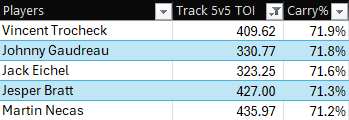
That number fell off to 57.8% this season.
The goal rate went up because the shooting percentage with him on the ice went up, but also because he was trying to make more dangerous passes. His rate of cross-slot passes at 5-on-5 rose a whopping 81% from 2022-23, so while he was shooting much less, he was making very dangerous seam passes much more often.
There is reason for optimism – Gaudreau's passing was legitimately very good – but if he doesn't have a big rebound in shot volume, he is, at most, a two-category fantasy player, and that's a big problem in a lot of formats.
Finally, it was not a good year for Elvis Merzlikins. He finished the season with an .897 save percentage, which was actually an improvement on the awful .876 from the year before, but below the league average. We can pin that on a bad team, but the aggregate save percentage of the other four goalies that appeared for Columbus was .903. Those four goalies combined for 0.12 goals saved above expected per 60 minutes, and Merzlikins was at 0.09. When four backup goalies outperform the starter who has three years left on his contract, it's not a good sign. He will be given a chance to rebound even further in 2024-25, and maybe he does with a better team around him, but he's now dead last in the NHL by goals saved above expected over the last three years.
What Went Right
It is hard to say much went right in a season where a team hoping to push for a playoff spot finished 29th in the league with one prized prospect missing nearly half the season due to injury and another prized prospect being sent to the AHL for a few months.
On the other hand, it was a successful sophomore season for Marchenko. He led the team in total goals (23) and power play goals (9). His per-minute point and shot rates increased, as did his per-minute hit rates, so he's trending in the right direction, and he absolutely has 30-goal upside next season.
It was also a good breakout year for Dmitri Voronkov. He finished second on the team behind Marchenko with six PP goals, and he was 1 of 4 Columbus forwards to score at least 1.0 goals per 60 minutes, along with Jenner, Marchenko, and Yegor Chinakhov. Among 315 forwards with at least 800 total minutes, Voronkov was 19th by individual expected goals rate, or in the 94th percentile. He has found a home around the net and that should complement their top-6 forward group next season very well.
Gudbranson had a solid multi-cat year with 6 goals, 26 points, 74 PIMs, 170 blocks, and 81 hits. There are a lot of prospects knocking on the door, but the team likes him, and he should be able to keep contributing close to these levels for the time being.
Where They Go From Here
Like every other team at the bottom, their big hope is landing Macklin Celebrini in the Draft Lottery. If they don't, there is still a lot to like.
Fantilli was held to just 49 games but had 27 points, was 1 of 2 Columbus forwards to finish over 2.0 points/60 at 5-on-5. He also had the highest shot attempt rate at all strengths for any rookie from the last three seasons. He did a lot of work on zone entries and carried the puck into the zone at a very high rate. Here are some comparable players by those measures this season:

Again, missing so much time makes it hard to call his season a fantasy success, but Fantilli showed a lot of what should make him an All-Star very soon.
Werenski returned to the offensive levels expected of him, Jiřiček was better than his demotion warranted, and there are a couple of veterans they can rely on. There is also Denton Mateychuk on the way, so this blue line should be very active on the ice very soon.
All of Marchenko, Voronkov, and Chinakhov had good years and more growth from them would really help develop secondary scoring that this team has been lacking for years. With Jordan Dumais knocking on the door and Fantilli on the cusp of a big breakout, these young forwards make a very good core to work with (presuming Dumais fulfills expectations).
The concern is at the top of the lineup.
Laine now has parts of four seasons in Columbus and has averaged 30 goals every 82 games. That is not what is expected of him, so hopefully he can return from the Assistance Program in a good place both physically and mentally, and can return as the 40-goal threat he was earlier in his career.
Gaudreau's playmaking rebounded, and he can help the team's scorers in this respect, but if he's a 15- to 20-goal player, and not a 30-goal player, he really doesn't bring much to fantasy rosters.
The long-standing issue with Jenner was back problems, which makes 2023-24 unfortunate because it was a broken jaw and a personal issue that limited his games played. He has two years left at a very good cap hit and a partial no-trade clause, so it's unlikely he's traded, and he can be a 30-goal, 50-point, 220-shot, 150-hit forward if he can cobble together an 80-game season. He hasn't done that since 2016-17, though.
On the bright side, they got a good run late in the season from Alex Nylander. If he can be a middle-6 producer, they now have him, Jenner, Gaudreau, Laine, Fantilli, Marchenko, Voronkov, Chinakhov, Kent Johnson, and Cole Sillinger. Add prospects like Dumais and Gavin Brindley, and all the pieces are here to have good veterans at the top of the roster, rising stars in the middle, and prospects developing at the bottom. It should be noted that even with all the injuries and underperformances, Columbus was 18th by shot attempts-for per minute at 5-on-5 and 12th by goals-for per minute. The power play was very bad, but the 5-on-5 scoring came around, and the pieces are there for a successful power play very soon.
There is goaltending to worry about. Merzlikins turned 30 years old earlier this month and has three years left on his contract with a $5.4M cap hit. He also has a partial no-trade clause, so trading him right now is going to be very hard (read: costly). With Merzlikins around, he could limit the team's ability to find out if either Daniil Tarasov or Jet Greaves can be their goalie for the next 5-7 years.
It is an interesting offseason for Columbus. They don't have any UFAs they need to sign, but they do have some RFAs like Alex Texier, Marchenko, Sillinger, Chinakhov, Nylander, Johnson, and Bean. With $23.5M in cap space, just an average cap hit of $3M per player would eat up almost all their space. Also, most are older RFAs as only Johnson and Sillinger are under 23 years old, so any sort of long-term extension (let's say six years for Marchenko) would bring a cap hit much, much higher than $3M. No matter what they do, they won't have much cap space, even if they let guys like Texier and Bean walk.
Columbus also doesn't have much for draft capital. They aren't trading this year's first-round pick unless it's a package that blows the doors off, and they have no second-round pick. If they make a splash, it's probably by trading one of their RFAs and attaching mid-round picks to them rather than just a picks-for-player deal.
All this is to say that the team will largely be the same in 2024-25 that it was in 2023-24. From a fantasy perspective, that may not be a bad thing. They could be a top-10 team at 5-on-5, scoring-wise, and there is lots of room for improvement on the power play. It is not far-fetched that, 12 months from now, we're looking at 30-goal seasons from Jenner and Marchenko, 20- to 25-goal seasons from at least two of Fantilli, Chinakhov, Nylander, and Voronkov, and 70-point seasons from Gaudreau and Werenski. And that also precludes a rebound year from Laine and/or Johnson.
Despite the franchise's historical allergy to offence, it is becoming the hallmark of this era of Columbus hockey, and that's great news for fantasy players who are paying attention. The key players just need to stay healthy.

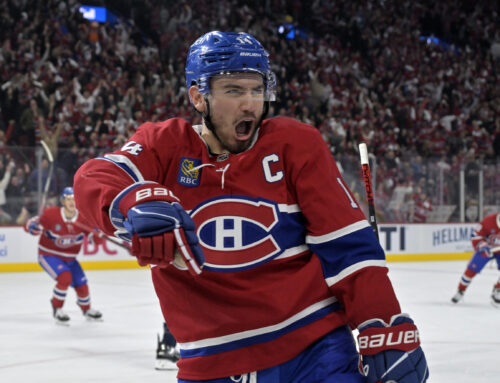
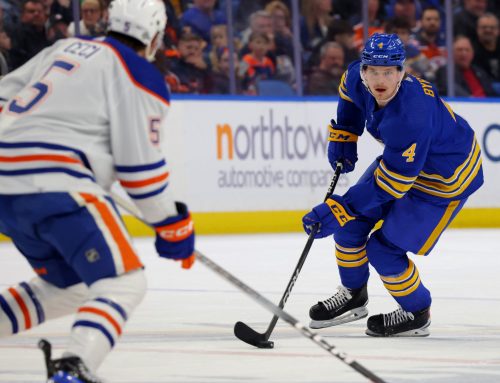
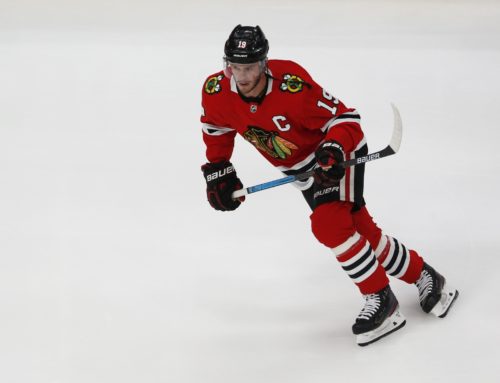
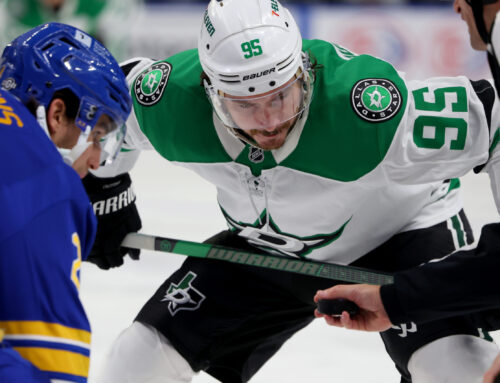
 BUF
BUF NYR
NYR CHI
CHI WSH
WSH CBJ
CBJ S.J
S.J VAN
VAN ANA
ANA COL
COL
